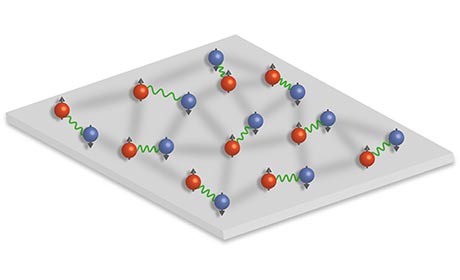Exploring the phenomenon of superconductivity

In a known and well-understood scenario, pairing is caused solely by the attraction between two fermions (green lines). However, Heidelberg scientists found that with strong interactions between the fermions, a different type of pairing takes place, which strongly depends on the density of the surrounding medium (gray shaded regions). This suggests that in this state, each particle is not only paired with one other particle, but that there are additional correlations with other particles in its surroundings. Figure: Puneet Murthy
Using ultracold atoms, researchers at Heidelberg University have found an exotic state of matter where the constituent particles pair up when limited to two dimensions. The findings from the field of quantum physics may hold important clues to intriguing phenomena of superconductivity. The results were published in Science magazine.
Superconductors are materials through which electricity can flow without any resistance once they are cooled below a certain critical temperature. The technologically most relevant class of materials, with exceptionally high critical temperatures for superconductivity, is poorly understood so far. There is evidence, however, that in order for superconductivity to occur, a certain type of particles – the fermions – must pair up.
Moreover, research has shown that materials which become superconducting at relatively high temperatures have layered structures. “This means that electrons in these systems can only move in two-dimensional planes”, explains Prof. Dr Selim Jochim of Heidelberg University’s Institute for Physics, who heads the project. “What we did not understand until now was how the interplay of pairing and dimensionality can lead to higher critical temperatures.”
To explore this question, researchers at the Center for Quantum Dynamics performed experiments in which they confined a gas of ultracold atoms in two-dimensional traps which they created using focused laser beams. “In solid-state materials like copper oxides, there are many different effects and impurities that make these materials difficult to study.
That is why we use ultracold atoms to simulate the behaviour of electrons in solids. This allows us to create very clean samples and gives us full control over the essential system parameters”, says Puneet Murthy, a PhD student at the Center for Quantum Dynamics at Heidelberg University and one of the lead authors of this publication.
Using a technique known as radio-frequency spectroscopy, the researchers measured the response of the atoms to a radio-wave pulse. From this response, they could tell exactly whether or not the particles were paired and in what way. These measurements were also performed for different strengths of interaction between fermions.
In the course of the experiments, the researchers discovered an exotic state of matter. Theory states that fermions with a weak interaction should pair up at the temperature at which they become superconductive. However, when the scientists increased the interaction between fermions, they found that pairing occurred at temperatures several times higher than the critical temperature.
“To achieve our ultimate goal of better understanding these phenomena, we will start with small systems that we put together atom by atom”, says Prof. Jochim. The research project also involved scientists from Heidelberg University’s Institute for Theoretical Physics and from Simon Fraser University in Vancouver (Canada).
Original publication:
P. A. Murthy, M. Neidig, R. Klemt, L. Bayha, I. Boettcher, T. Enss, M. Holten, G. Zuern, P. Preiss, S. Jochim: High Temperature Pairing in a strongly interacting two-dimensional Fermi gas. Science (published online on 21 December 2017), doi: 10.1126/science.aan5950
Contact:
Prof. Dr Selim Jochim
Institute for Physics
Center for Quantum Dynamics
Phone +49 6221 54-19472
jochim@uni-heidelberg.de
Communications and Marketing
Press Office
Phone +49 6221 54-2311
presse@rektorat.uni-heidelberg.de
Media Contact
All latest news from the category: Physics and Astronomy
This area deals with the fundamental laws and building blocks of nature and how they interact, the properties and the behavior of matter, and research into space and time and their structures.
innovations-report provides in-depth reports and articles on subjects such as astrophysics, laser technologies, nuclear, quantum, particle and solid-state physics, nanotechnologies, planetary research and findings (Mars, Venus) and developments related to the Hubble Telescope.
Newest articles

A universal framework for spatial biology
SpatialData is a freely accessible tool to unify and integrate data from different omics technologies accounting for spatial information, which can provide holistic insights into health and disease. Biological processes…

How complex biological processes arise
A $20 million grant from the U.S. National Science Foundation (NSF) will support the establishment and operation of the National Synthesis Center for Emergence in the Molecular and Cellular Sciences (NCEMS) at…

Airborne single-photon lidar system achieves high-resolution 3D imaging
Compact, low-power system opens doors for photon-efficient drone and satellite-based environmental monitoring and mapping. Researchers have developed a compact and lightweight single-photon airborne lidar system that can acquire high-resolution 3D…





















